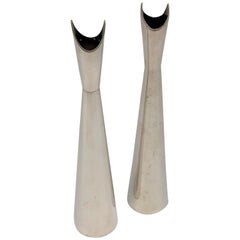Christofle Cardinal
Recent Sales
Vintage 1950s French Mid-Century Modern Vases
Metal
Vintage 1970s French Sheffield and Silverplate
Silver Plate
Mid-20th Century French Mid-Century Modern Sheffield and Silverplate
Metal
Vintage 1960s French Mid-Century Modern Vases
Metal
Lino Sabattini for sale on 1stDibs
Lino Sabattini was the preeminent figure in modern Italian silver and metalware design. His expansive and diverse body of work is marked by its strength and boldness, whether in dynamic forms that suggest the thrust and power of Italian Futurist art and design or light and curvaceous biomorphic serveware and decorative objects.
Sabattini was largely self-taught as a designer. Born in the northern Italian town of Correggio, he learned metalsmithing techniques while working in the studio of a maker of brass tableware. He also served as an apprentice of sorts to the expatriate German ceramist Roland Hettner, who taught Sabattini about fluidity of form and showed him how shapes derive from the behavior of materials.
At age 30, Sabattini opened a studio in Milan, and his work quickly came to the attention of Gio Ponti, who decided to publish it in Domus, the Italian design legend's influential design and architecture magazine. Ponti also arranged for Sabattini’s creations to be included in a 1956 exhibition of contemporary Italian design in Paris. The principals of Christofle, the revered French silverware maker, were so impressed that they hired the young designer as the firm’s artistic director, a post he held until 1963. Sabattini, who would also go on to design ceramic wares for Rosenthal, returned home to open Argenteria Sabattini in Bregnano, a company still in business today.
A designer with a questing curiosity and ever-evolving aesthetic sensibility, Sabattini couldn’t be pinned down to one particular style. His best-known work, the Como coffee and tea service of 1956, has an elegant, attenuated and energetic form; his Stairs coffee and tea service (1971), meanwhile, is a clever group of simple columnar shapes in stepped heights, which nest together in a compact arrangement. Other Sabattini pieces have dramatic angles, or sweeping, wing-like flourishes, or consist of perforated ovoids somehow reminiscent of sculptures by Brancusi. In any style, Sabattini produced objects of singular fascination.
Find a range of vintage Lino Sabattini vases and other decorative objects on 1stDibs.
Finding the Right vases for You
Whether it’s a Chinese Han dynasty glazed ceramic wine vessel, a work of Murano glass or a hand-painted Scandinavian modern stoneware piece, a fine vase brings a piece of history into your space as much as it adds a sophisticated dynamic.
Like sculptures or paintings, antique and vintage vases are considered works of fine art. Once offered as tributes to ancient rulers, vases continue to be gifted to heads of state today. Over time, decorative porcelain vases have become family heirlooms to be displayed prominently in our homes — loved pieces treasured from generation to generation.
The functional value of vases is well known. They were traditionally utilized as vessels for carrying dry goods or liquids, so some have handles and feature an opening at the top (where they flare back out). While artists have explored wildly sculptural alternatives over time, the most conventional vase shape is characterized by a bulbous base and a body with shoulders where the form curves inward.
Owing to their intrinsic functionality, vases are quite possibly versatile in ways few other art forms can match. They’re typically taller than they are wide. Some have a neck that offers height and is ideal for the stems of cut flowers. To pair with your mid-century modern decor, the right vase will be an elegant receptacle for leafy snake plants on your teak dining table, or, in the case of welcoming guests on your doorstep, a large ceramic floor vase for long tree branches or sticks — perhaps one crafted in the Art Nouveau style — works wonders.
Interior designers include vases of every type, size and style in their projects — be the canvas indoors or outdoors — often introducing a splash of color and a range of textures to an entryway or merely calling attention to nature’s asymmetries by bringing more organically shaped decorative objects into a home.
On 1stDibs, you can browse our collection of vases by material, including ceramic, glass, porcelain and more. Sizes range from tiny bud vases to massive statement pieces and every size in between.

